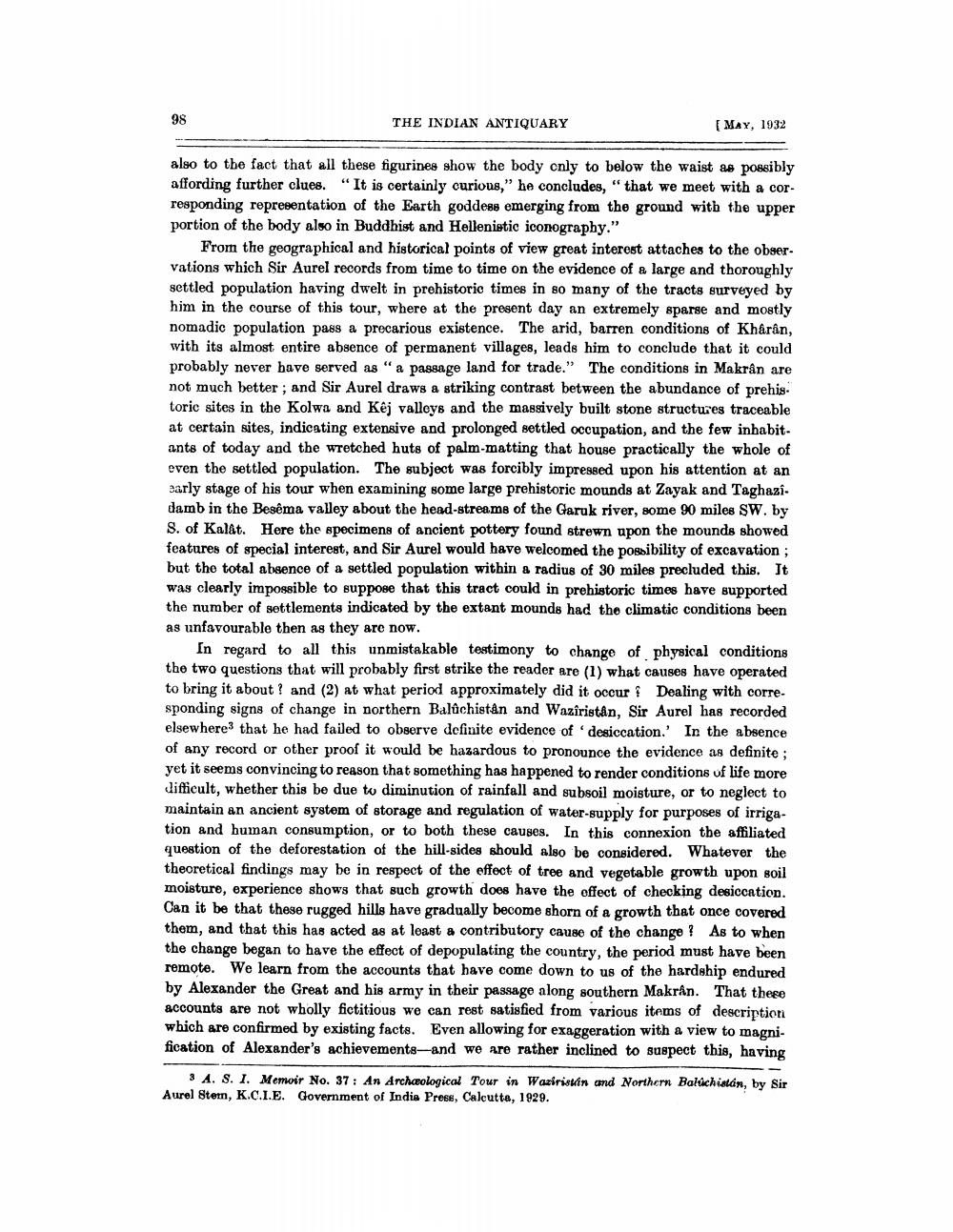________________
THE INDIAN ANTIQUARY
(MAY, 1932
also to the fact that all these figurines show the body cnly to below the waist as possibly affording further clues. “It is certainly curious," he concludes," that we meet with a corresponding representation of the Earth goddess emerging from the ground with the upper portion of the body also in Buddhist and Hellenistic iconography."
From the geographical and historical points of view great interest attaches to the observations which Sir Aurel records from time to time on the evidence of a large and thoroughly settled population having dwelt in prehistoric times in so many of the tracts surveyed by him in the course of this tour, where at the present day an extremely sparse and mostly nomadic population pass a precarious existence. The arid, barren conditions of Kharan, with its almost entire absence of permanent villages, leads him to conclude that it could probably never have served as "a passage land for trade." The conditions in Makran are not much better, and Sir Aurel draws a striking contrast between the abundance of prehis. toric sites in the Kolwa and Kej valloys and the massively built stone structures traceable at certain sites, indicating extensive and prolonged settled occupation, and the few inbabit. ants of today and the wretched huts of palm-matting that house practically the whole of even the settled population. The subject was forcibly impressed upon his attention at an early stage of his tour when examining some large prehistoric mounds at Zayak and Taghazi. damb in the Besêma valley about the head-streams of the Garuk river, some 90 miles SW. by S. of Kalât. Here the specimens of ancient pottery found strewn upon the mounds showed features of special interest, and Sir Aurel would have welcomed the possibility of excavation ; but the total absence of a settled population within a radius of 30 miles precluded this. It was clearly impossible to suppose that this tract could in prehistoric times have supported the number of settlements indicated by the extant mounds had the climatic conditions been as unfavourable then as they are now.
In regard to all this unmistakable testimony to change of physical conditions the two questions that will probably first strike the reader are (1) what causes have operated to bring it about? and (2) at what period approximately did it occur Dealing with corre. sponding signs of change in northern Balûchistan and Wazîristân, Sir Aurel has recorded elsewhere that he had failed to observe definite evidence of desiccation. In the absence of any record or other proof it would be hazardous to pronounce the evidence as definite; yet it seems convincing to reason that something has happened to render conditions of life more difficult, whether this be due to diminution of rainfall and subsoil moisture, or to neglect to maintain an ancient system of storage and regulation of water-supply for purposes of irrigation and human consumption, or to both these causes. In this connexion the affiliated question of the deforestation of the hill-sides should also be considered. Whatever the theoretical findings may be in respect of the effect of tree and vegetable growth upon soil moisture, experience shows that such growth does have the effect of checking desiccation. Can it be that these rugged hills have gradually become shorn of a growth that once covered them, and that this has acted as at least a contributory cause of the change? As to when the change began to have the effect of depopulating the country, the period must have been remote. We learn from the accounts that have come down to us of the hardship endured by Alexander the Great and his army in their passage along southern Makrån. That these accounts are not wholly fictitious we can rest satisfied from various items of description which are confirmed by existing facts. Even allowing for exaggeration with a view to magnification of Alexander's achievements and we are rather inclined to suspect this, having
3 4. S. 1. Memoir No. 37: An Archaeological Tour in Waziriskin and Northern Baluchistán, by Sir Aurel Stern, K.C.I.E. Government of India Prese, Calcutta, 1929.




